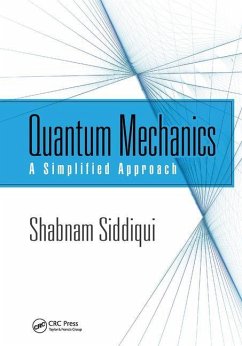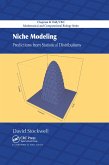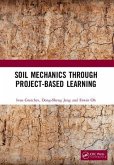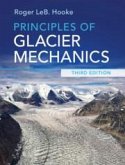Schade – dieser Artikel ist leider ausverkauft. Sobald wir wissen, ob und wann der Artikel wieder verfügbar ist, informieren wir Sie an dieser Stelle.
- Broschiertes Buch
- Merkliste
- Auf die Merkliste
- Bewerten Bewerten
- Teilen
- Produkt teilen
- Produkterinnerung
- Produkterinnerung
Providing a clear distinction between classical and quantum logic, this unique introductory quantum mechanics text provides concepts and problem solving techniques with an active, learning-based approach.
Andere Kunden interessierten sich auch für
![A Practical Guide to Domestic Energy Saving Technologies A Practical Guide to Domestic Energy Saving Technologies]() Christopher KitcherA Practical Guide to Domestic Energy Saving Technologies32,99 €
Christopher KitcherA Practical Guide to Domestic Energy Saving Technologies32,99 €![Niche Modeling Niche Modeling]() David StockwellNiche Modeling97,99 €
David StockwellNiche Modeling97,99 €![Advances in SAR Remote Sensing of Oceans Advances in SAR Remote Sensing of Oceans]() Advances in SAR Remote Sensing of Oceans60,99 €
Advances in SAR Remote Sensing of Oceans60,99 €![Trolleybus Revolution - UK Trolleybus Revolution - UK]() Terence P O'HalloranTrolleybus Revolution - UK19,99 €
Terence P O'HalloranTrolleybus Revolution - UK19,99 €![Soil Mechanics Through Project-Based Learning Soil Mechanics Through Project-Based Learning]() Ivan GratchevSoil Mechanics Through Project-Based Learning74,99 €
Ivan GratchevSoil Mechanics Through Project-Based Learning74,99 €![Electrical Science for Technicians Electrical Science for Technicians]() Adrian WaygoodElectrical Science for Technicians55,99 €
Adrian WaygoodElectrical Science for Technicians55,99 €![Principles of Glacier Mechanics Principles of Glacier Mechanics]() Roger Leb HookePrinciples of Glacier Mechanics86,99 €
Roger Leb HookePrinciples of Glacier Mechanics86,99 €-
Providing a clear distinction between classical and quantum logic, this unique introductory quantum mechanics text provides concepts and problem solving techniques with an active, learning-based approach.
Produktdetails
- Produktdetails
- Verlag: Taylor & Francis Ltd
- Seitenzahl: 260
- Erscheinungstermin: 2. Oktober 2023
- Englisch
- Abmessung: 254mm x 178mm
- Gewicht: 480g
- ISBN-13: 9781032652443
- ISBN-10: 1032652446
- Artikelnr.: 70113427
- Herstellerkennzeichnung
- Produktsicherheitsverantwortliche/r
- Europaallee 1
- 36244 Bad Hersfeld
- gpsr@libri.de
- Verlag: Taylor & Francis Ltd
- Seitenzahl: 260
- Erscheinungstermin: 2. Oktober 2023
- Englisch
- Abmessung: 254mm x 178mm
- Gewicht: 480g
- ISBN-13: 9781032652443
- ISBN-10: 1032652446
- Artikelnr.: 70113427
- Herstellerkennzeichnung
- Produktsicherheitsverantwortliche/r
- Europaallee 1
- 36244 Bad Hersfeld
- gpsr@libri.de
Dr. Shabnam Siddiqui is a research assistant professor at Louisiana Tech University, LA. She teaches physics and conducts research for developing electrochemical microsensors using carbon nanomaterials. She applies active learning approaches for teaching physics courses and focuses on developing new methods for learning physics, and quantum mechanics. Dr. Siddiqui studies properties of carbon nanomaterials for attaining reliable and real-time sensing. She has authored over 20 peer reviewed journal papers. She earned a PhD in physics in quantum computing and quantum information in 2006 from the University of Arkansas at Fayetteville, AR. Dr. Siddiqui received postdoctoral training at NASA Ames Research Center, CA, and the University of Pittsburgh, PA. She had also worked at Advanced Diamond Technologies, IL prior to joining Louisiana Tech.
Electromagnetic radiation behaving as particle. Blackbody Radiation. The
Photoelectric effect. X-Rays. Particles behaving as wave: concept of matter
waves. De Broglie's matter waves. Double-slit Experiment. Heisenberg's
Uncertainty Principle. Measurement and Observation. Wave Mechanics:
Schrodinger's wave equation of a particle. The Schrodinger equation.
Stationary states. Expectation values, Uncertainties and operators.
Particle-Wave propagation (wavepacket, phase and group velocities).
Differences between quantum mechanics and classical mechanics. Wave
Mechanics: Schrodinger's wave equation of a particle- II. Particle in a
box-The infinite square well. The finite square well. The free-particle.
The potential step. The potential barrier and tunneling. Matrix Mechanics:
Formalism. Matrix Algebra. Transformation theory. Matrix theory of the
harmonic oscillator. Equation of motion using matrix mechanics. Differences
between matrix mechanics and wave equation approaches. Quantum Mechanics in
Three Dimensions and the Hydrogen Atom. The Schrodinger Equation in Three
Dimensions. The 3D Infinite well. Energy Quantization and Spectral Lines in
Hydrogen Atom. The Schrodinger Equation for a Central Force. Quantum
Mechanics in three dimensions - II. Applications of Quantum Mechanics
Photoelectric effect. X-Rays. Particles behaving as wave: concept of matter
waves. De Broglie's matter waves. Double-slit Experiment. Heisenberg's
Uncertainty Principle. Measurement and Observation. Wave Mechanics:
Schrodinger's wave equation of a particle. The Schrodinger equation.
Stationary states. Expectation values, Uncertainties and operators.
Particle-Wave propagation (wavepacket, phase and group velocities).
Differences between quantum mechanics and classical mechanics. Wave
Mechanics: Schrodinger's wave equation of a particle- II. Particle in a
box-The infinite square well. The finite square well. The free-particle.
The potential step. The potential barrier and tunneling. Matrix Mechanics:
Formalism. Matrix Algebra. Transformation theory. Matrix theory of the
harmonic oscillator. Equation of motion using matrix mechanics. Differences
between matrix mechanics and wave equation approaches. Quantum Mechanics in
Three Dimensions and the Hydrogen Atom. The Schrodinger Equation in Three
Dimensions. The 3D Infinite well. Energy Quantization and Spectral Lines in
Hydrogen Atom. The Schrodinger Equation for a Central Force. Quantum
Mechanics in three dimensions - II. Applications of Quantum Mechanics
Electromagnetic radiation behaving as particle. Blackbody Radiation. The
Photoelectric effect. X-Rays. Particles behaving as wave: concept of matter
waves. De Broglie's matter waves. Double-slit Experiment. Heisenberg's
Uncertainty Principle. Measurement and Observation. Wave Mechanics:
Schrodinger's wave equation of a particle. The Schrodinger equation.
Stationary states. Expectation values, Uncertainties and operators.
Particle-Wave propagation (wavepacket, phase and group velocities).
Differences between quantum mechanics and classical mechanics. Wave
Mechanics: Schrodinger's wave equation of a particle- II. Particle in a
box-The infinite square well. The finite square well. The free-particle.
The potential step. The potential barrier and tunneling. Matrix Mechanics:
Formalism. Matrix Algebra. Transformation theory. Matrix theory of the
harmonic oscillator. Equation of motion using matrix mechanics. Differences
between matrix mechanics and wave equation approaches. Quantum Mechanics in
Three Dimensions and the Hydrogen Atom. The Schrodinger Equation in Three
Dimensions. The 3D Infinite well. Energy Quantization and Spectral Lines in
Hydrogen Atom. The Schrodinger Equation for a Central Force. Quantum
Mechanics in three dimensions - II. Applications of Quantum Mechanics
Photoelectric effect. X-Rays. Particles behaving as wave: concept of matter
waves. De Broglie's matter waves. Double-slit Experiment. Heisenberg's
Uncertainty Principle. Measurement and Observation. Wave Mechanics:
Schrodinger's wave equation of a particle. The Schrodinger equation.
Stationary states. Expectation values, Uncertainties and operators.
Particle-Wave propagation (wavepacket, phase and group velocities).
Differences between quantum mechanics and classical mechanics. Wave
Mechanics: Schrodinger's wave equation of a particle- II. Particle in a
box-The infinite square well. The finite square well. The free-particle.
The potential step. The potential barrier and tunneling. Matrix Mechanics:
Formalism. Matrix Algebra. Transformation theory. Matrix theory of the
harmonic oscillator. Equation of motion using matrix mechanics. Differences
between matrix mechanics and wave equation approaches. Quantum Mechanics in
Three Dimensions and the Hydrogen Atom. The Schrodinger Equation in Three
Dimensions. The 3D Infinite well. Energy Quantization and Spectral Lines in
Hydrogen Atom. The Schrodinger Equation for a Central Force. Quantum
Mechanics in three dimensions - II. Applications of Quantum Mechanics








